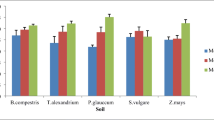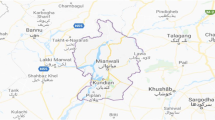Abstract
Heavy metal pollution in soil, forage, and animals is serious concern nowadays. Current research was conducted in Sargodha to find out the relationship of animals related to the forages and soil pollution. Three sites were selected with three different treatments; site I irrigated with ground water, site II irrigated with the canal water, and site III irrigated with the wastewater. Samples of soil, forage, and animals (blood, hair, feces) were collected from selected sites and were analyzed for metal analysis using atomic absorption spectroscopy. Results indicated that Zn in soil ranged from 24.12 to 37.39 mg/kg; forage, 31.98–44.47 mg/kg; blood of animals, 1.49–2.72 mg/L; hair of animals, 1.37–2.41 mg/kg; and feces of animals, 1.06–2.97 mg/kg. The concentration of zinc in soil and forage was less than permissible limit, but concentration in blood of animals was greater than critical limit suggesting the presence of metal. Bio-concentration factor indicated that metal was accumulated in forages growing at irrigated site. HRI concentration (2.024 mg/kg/day) suggests the accumulation of zinc in animal tissues. Pollution load index and enrichment factor were within the range.




Similar content being viewed by others
Availability of data and materials
All data generated or analyzed during this study are included in this published article.
References
Alade IO, A.b.d Rahman MA, Saleh TA (2019) Predicting the specific heat capacity of alumina/ethylene glycol nanofluids using support vector regression model optimized with Bayesian algorithm. Solar Energy 183:74–82
Aslam J, Khan SA, Khan SH (2013) Heavy metals contamination in roadside soil near different traffic signals in Dubai, United Arab Emirates. J Saudi Chem Soc 17(3):315–319
Bahadur V, Mishchenko L, Hatton B, Taylor JA, Aizenberg J, Krupenkin T (2011) Predictive model for ice formation on superhydrophobic surfaces. Langmuir 27(23):14143–14150
Buat-Menard RA, Chesselet R (1979) Variable influence of the atmospheric flux on the trace metal chemistry of oceanic suspended matter. J Earth Planet Sci Lett 42:398–411
Campbell CD, Planks CO (1992) An assessment of the hazards of lead in food. Regul Toxicol Pharmacol 16:265–277
Ciba J, Zołotajkin M, Kluczka J, Loska K, Cebula J (2003) Comparison of methods for leaching heavy metals from composts. Waste Manage 23(10):897–905
Cui YJ, Zhu YG, Zhai RH, Chen DY, Huang YZ, Qiu Y, Liang JZ (2004) Transfer of metals from soil to vegetables in an area near a smelter in Nanning China. Environment International 30(6):785–791
Dirksen W (2002) Water management structures in Europe. Irrigation and Drainage: the Journal of the International Commission on Irrigation and Drainage 51(3):199–211
Dosumu OO, Salam NA, Oguntoy NS (2005) Trace metals bioaccumulation by some Nigerian vegetables. Centrepoint 13(1):23–32
FAO/WHO (2001) Codex Alimentarius Commission. Food additive and contaminants. Joint FAO/WHO Food Standards Programme, ALINORM 01/12A, pp. 1–289.
Faridullah IM, Sabir MA (2012) Investigation of heavy metals using various extraction methods in livestock manures. Communications in soil science and plant analysis. 43(21):2801 2808
Guo X, Cui X, Li H (2020) Effects of fillers combined with biosorbents on nutrient and heavy metal removal from biogas slurry in constructed wetlands. Sci Total Environ 703:134788
Kannaujia RK, Singh S (2012) Levels, spatial distribution and possible sources of heavy metal contamination of suburban soil in Jhansi. Orient J Chem 28(4):1913
Liu JG, Qian M, Cai GL, Yang JC, Zhu QS (2007) Uptake and translocation of Cd in different rice cultivars and the relation with Cd accumulation in rice grain. J Hazard Mater 143:443–447
Moreki JC, Woods TO, Nthoiwa PG (2013) Estimation of the concentration of heavy metals in forages harvested around Dibete area Botswana. Intern J Innovative Res Sci Eng Tech 2(8):3060–4071
Murray JW (2014) Ecology and palaeoecology of benthic foraminifera. Routledge
Nadeem M, Khan ZI, Ghazal M, Akhter M, Akhter P, Ahmad K, Ainee A (2020) An assessment of Zn and Pb in buffaloes fed on forages irrigated with wastewater in Sahiwal, Sargodha Pakistan. Pure and Applied Biology (PAB) 9(1):728–742
Nazir R, Khan M, Masab M, Rehman HU, Rauf NU, Shahab S, Shaheen Z (2015) Accumulation of heavy metals (Ni, Cu, Cd, Cr, Pb, Zn, Fe) in the soil, water and plants and analysis of physico-chemical parameters of soil and water collected from Tanda Dam Kohat. J Pharm Sci Res 7(3):89
Sajjad K, Farooq R, Shahbaz S, Khan MA, Sadique M (2009) Health risk assessment of heavy metals for population via consumption of vegetables. World Applied Science Journal 6:1602–1606
Sarwar S, Ayyub MA, Rezgui M, Nisar S, Jilani MI (2016) A review of habitat. Sci 9(4):9–55
Shirani A, Dernoncourt F, Lipka N, Asente P, Echevarria J, Solorio T (2020) Semeval-2020 task 10: emphasis selection for written text in visual media. arXiv preprint arXiv:2008.03274
Shirani K, Yousefsani BS, Shirani M, Karimi G (2020) Protective effects of naringin against drugs and chemical toxins induced hepatotoxicity: a review. Phytother Res 34(8):1734–1744
Siddique I, Liang ZT, Lisa MA, Wang Q, Xu ZB (2019) Alternative methods for measurement of the global polarization of Λ hyperons. Chinese Physics C 43(1):014103
Singh A, Sharma RK, Agrawal M, Marshall FM (2010) Health risk assessment of heavy metals via dietary intake of food stuffs from the wastewater irrigated site of a dry tropical area of India. Food Chem Toxicol 48(2):611–619
Dutch Standard (2000). Circular on target values and intervention values for soil remediation. Dutch Ministry of Housing, Spatial Planning and Environment, Netherlands Government Gazette
Steel R G, Torrie JH (1980). Principles and procedures of statistics McGraw-Hill Book Co. Inc., New York, 481
Zeng J, Yang L, Wang X, Wang WX, Wu QL (2012) Metal accumulation in fish from different zones of a large, shallow freshwater lake. Ecotoxicol Environ Saf 86:116–124
Acknowledgements
The authors express their appreciation to the Researchers Supporting Project (RSP-2021/193) at King Saud University, Riyadh, Saudi Arabia.
Author information
Authors and Affiliations
Contributions
AM and MSE were responsible for writing the manuscript. ZIK and KA supervised the study. AM, JA, AA, YD, ISM, RS, and SA were responsible for conducting the experiments and the data analysis. MN and SA were responsible for analyzing and interpreting the data. All authors read and approved the final manuscript.
Corresponding author
Ethics declarations
Ethics approval
All the study protocols were approved by the institutional animal ethics committee, University of Sargodha (Approval No. 25-A18 IEC UOS). All the experiments performed complied with the rules of the National Research Council, and all methods were performed keeping in view the ethical principles regarding animal’s accordance with relevant guidelines and regulations.
Consent to participate
All authors voluntarily participate in this research study.
Consent for publication
All authors consent to the publication of the manuscript.
Conflict of interest
The authors declare no competing interests.
Additional information
Responsible Editor: Lotfi Aleya
Publisher’s note
Springer Nature remains neutral with regard to jurisdictional claims in published maps and institutional affiliations.
Rights and permissions
About this article
Cite this article
Maqsood, A., Khan, Z.I., Ahmad, K. et al. Quantitative evaluation of zinc metal in meadows and ruminants for health assessment: implications for humans. Environ Sci Pollut Res 29, 21634–21641 (2022). https://doi.org/10.1007/s11356-021-17264-1
Received:
Accepted:
Published:
Issue Date:
DOI: https://doi.org/10.1007/s11356-021-17264-1




